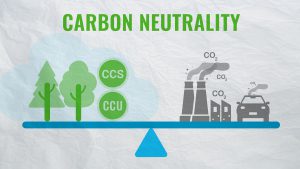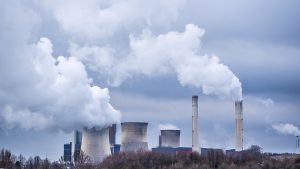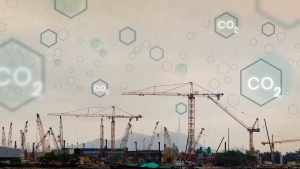The goal of Carbon Neutrality is related to a better environment, climate, and overall surroundings and belongs to everyone. Each and every one of us has a responsibility to take action to fight cruel changes in the world. We are all impacted, and no one person can address the issue on their own.
But if we group together and work hard, we can have a big impact and change the world for the better.
Carbon-neutrality concept is one of the many important steps that are on the list of goals for a better future.
Have you all ever wondered why all of a sudden there are debates on the environment and climate? Why climate is becoming an alarming issue? What exactly is going on? And what Earth would suffer if this alarm prolongs?
Certainly, there is a lot going on and climate is not something that has all of a sudden started showing something. It is an age-long story that people are now paying attention to.
The goal of Carbon Neutrality and being Carbon-neutral is all about it. If we understand the scenario, it is like a story and series of happening.
Here is all in simple words!
Earth was like a beautiful Greentown prominent with its perfect rivers, green fields, great climate, good environment, mountains, and whatnot?
The beautiful sky on the top and the beautiful waters below presented a wonderful place. Everything was environmentally-friendly with good climate control.
Nonetheless, the earth still owns all of it, but sadly with some additions. The additions that were supposed to be for the better are making things worse. Now, the air turned foggy, the fields faded away, and the people are coughing and sneezing.
Natural balance is disturbed, sea levels are disturbed, ice is melting, the temperature is rising, the environment has become home to intoxicants and the health of people is at risk.
And all the suffering is in the hands of the emissions released into the air, particularly the carbon emissions.
When fossil fuels like coal, oil, and gas are used, unsafe gases are produced that set up heat in our atmosphere. Emission is high in levels and to balance the carbon emissions the goal of Carbon neutrality can help with it.
When we release the same amount of carbon into the atmosphere as we remove it, we are considered at the carbon-neutral level.
But how can we remove carbon from the air?
We can become carbon neutral in numerous ways, like reducing our carbon emissions and using clean, renewable energy sources like solar and wind power in place of fossil fuels. We can utilize less-powerful vehicles and energy-efficient appliances as well.
The whole point is not to be hard on the environment. That is it. Be easy and use things that are eco-friendly and environmentally-friendly.
The global issue of climate change is a major one. Every person who lived in the world had to contribute to this work.
The urgency of the environmental problem and the Goal of Carbon Neutrality is today. We all are already late and responsible.
We accept the fact that things are not okay.
Now, let us all deeply understand the terms and things going on right now.
What is carbon neutrality?

As the name tells, it is a stable state of balance between carbon release and absorption.
To be on the carbon-neutral level, our emissions of harmful carbon must be balanced out by our removal of harmful carbon from the atmosphere. It must be balanced like a scale. By using greener energy sources and increasing our energy efficiency, we can and hope to lower the amount of carbon emissions that we produce.
The important goal of Carbon Neutrality is the quantity of carbon emissions we send into the atmosphere and the amount of carbon we can remove from the atmosphere. By doing this, we can reduce the effects of climate change and contribute to stopping further environmental harm.
In the Carbon-neutrality game, two things are involved.
- We should first make an effort to produce less dangerous environmentally-friendly gases by replacing renewable energy sources like wind and sunshine with fossil fuels.
- Second, there are methods we can use to get dangerous gases out of the air. Planting a lot of trees is one approach to do this.
Trees are the cleaning machinery of nature. Their leaves, and branches, serve as storage spaces for the carbon dioxide they absorb.
Both steps are important and equally need to be implemented in achieving the Goal of Carbon Neutrality.
Being at a Carbon-neutral level, therefore, means that we are making every effort to prevent adding more unsafe gases to the air than we can remove.
It is as good as working to preserve our air safe and healthy for everyone as well as the planet.
Why is there any need for carbon neutrality?

Simple! Because none of us want to drown in rising sea levels or die in terrible natural disasters.
To combat climate change, save the environment, and ensure a sustainable future for future generations, achieving the Goal of Carbon Neutrality is important, needed, and has to be implemented.
It is important to achieve a Carbon-neutrality level if we want to stop and stop climate change. We can repair the harm that human activity has done to the environment and guarantee the survival of our world by accepting responsibility for our actions and working toward a sustainable lifestyle. It is our responsibility to bring things back into balance and live in harmony with the planet.
Achieving carbon neutrality by the middle of this century is one amazing strategy to accomplish climate control and stability.
At present, think through Earth as a massive regulator attempting to maintain equilibrium at its best. However, we keep releasing excessive amounts of dangerous substances into the air and it is like putting petrol on the volcano.
This is the reason why climate suddenly becomes strange and unpredictable.
We must attain the Goal of Carbon Neutrality and press the reset button to correct this. It’s like repairing the Earth’s regulator, which badly needs a good time.
It is no more superheroes in films, but now it is carbon-free superheroes which definitely we all are.
The important thing to note for the Goal of Carbon Neutrality

Even though becoming carbon neutral is a big step, our environmental duties don’t end there. While investing in renewable energy and buying carbon credits are good things to do, we must be careful not to just pass the carbon blame by relying on these methods.
Prioritizing activities that directly address the original causes of environmental harm is necessary if we want to actually have a major impact on climate control.
We must also actively look for less destructive alternatives in the areas of food production, transportation, and energy use.
We can protect the environment for future generations by taking a comprehensive approach that combines lowering carbon emissions, supporting sustainable behaviors, and looking for environmentally-friendly alternatives across multiple industries.
To establish a sustainable and renewing future, we must fundamentally modify our habits and systems along with reducing our carbon footprint and reaching the Goal of Carbon Neutrality.
See how much Carbon emissions have affected the world

It is not just the debates, seminars, or lectures. Look how things are harmfully changing.
- The average atmospheric CO2 content on a worldwide scale increased from 285 ppm in the year 1850 to 415 ppm by 2020.
- Over the years 1850 to 2020, the average surface temperature on Earth increased by around 1.2°C, proving of no climate control.
- Limiting the temperature increase from preindustrial levels by 2100, 1.5°C–2.0°C is the Goal of Carbon Neutrality by 2050.
- The threat posed by sea level rise might affect more than 100 million people in this century and even more in the long run.
- With a sensitivity of 20 meters per °C of temperature change, the sea level has varied by around 200 meters during the course of Earth’s history.
- While sea levels have risen by 0.24 meters during the preindustrial era, the Earth’s surface temperature has increased by 1.2°C.
- Depending on the scenario for fossil fuel output, the estimated sea level rise by 2100 ranges from 0.3 to 1.5 meters.
The atmospheric CO2 must be decreased to levels comparable to those of preindustrial times to stop the slow and long-term rise in sea levels.
Ways for Achieving Carbon-Neutrality Levels

The goal of Carbon Neutrality can be achieved with the following measures
- Substitute carbon-free renewable energy sources, such as solar, wind, hydropower, geothermal, and nuclear power, for fossil fuels like coal and oil. These sources of energy are plentiful and can supply all of our energy requirements without emitting any greenhouse gases.
- For the Carbon-neutral level, implement methods to collect and store carbon dioxide (CO2) emissions from industrial activities so that they are not released into the atmosphere. Thus, the overall carbon impact is decreased.
- Reduce your energy use for climate control by implementing energy-saving techniques and technologies like energy-efficient appliances, and encouraging conservation initiatives.
- Make natural carbon sinks, such as forests and oceans. They are more effective at absorbing and storing carbon dioxide.
- Use biomass energy to generate power instead of relying on fossil fuels. Biomass energy is energy produced from organic material such as agricultural waste or sustainably farmed crops.
- For the Carbon-neutrality era, create platforms for businesses to trade carbon credits and participate in projects that reduce emissions.
- Encourage people to live energy-efficient lifestyles by promoting actions like cutting back on wasteful energy use, taking public transportation, and embracing sustainable lifestyles.
- For achieving the Goal of Carbon Neutrality, Encourage the use of electric automobiles, support public transportation, and create infrastructure for cycling and walking for energy-efficient mobility. By moving away from fossil fuel-powered vehicles, the transportation sector, a major source of carbon emissions, will produce fewer emissions.
- Implement techniques that lower agricultural emissions, such as precision farming, organic farming, and a lesser reliance on synthetic fertilizers for the Goal of Carbon Neutrality. Sustainable farming may protect carbon stored in soils and reduce emissions.
- Adopt a circular economy approach that encourages recycling, reuse, and waste reduction. We can lower the emissions linked to the manufacture and disposal of items by cutting back on resource consumption and waste creation.
- Encourage the construction of environmentally-friendly and energy-efficient structures. This includes adopting efficient heating, cooling, and lighting systems, as well as renewable energy sources and improved insulation.
- Spend money on Research and development to advance sustainable practices, carbon capture technology, and clean technologies.
How the world would look in the future if we fail to achieve the Goal of Carbon Neutrality?

A world that didn’t attain a Carbon-neutrality era in 2050 would be on the edge of an uncertain future. As a result of our collective inaction on climate change, the world and its inhabitants would begin to feel the effects more and more.
The effects of climate change would worsen as time passed without significant cuts in carbon emissions.
- Around the world, extreme weather incidences would cause devastation, with sweltering heat waves, prolonged droughts, deadly floods, and fierce storms and these things would become the new normal.
- The delicate balance of ecosystems would get upset and once-thriving habitats started to break, putting in danger the existence of many species.
- The constant combustion of fossil fuels would increase the pollution in the air and disturb climate control.
- People would be experiencing the effects of the deteriorating air quality with zero, environmentally-friendly elements, with their health declining due to the burden of cardiovascular and respiratory illnesses.
- The demand for breathing, cleaner air would become higher.
- The constant rise of the oceans would be perhaps one of the most obvious consequences of our incapability to reduce carbon emissions and climate control. Coastal villages would be continually flooded by the rising sea levels.
- Low-lying communities and weak islands would be in immediate danger of being submerged by the rising seas.
- The world’s non-renewable environmentally-friendly resources would be running out faster and faster with each passing year.
- Societies would struggle with energy instability and geopolitical conflicts during this disruption. As countries compete for control over the remaining fossil fuel reserves, conflicts and power struggles between them would be driven by the shrinking supply of accessible, affordable, and clean energy sources.
- The two necessities of life food and water would become scarcer.
- Agriculture systems would struggle to produce enough food to feed a growing population because of unpredictable weather patterns and lessening water supplies.
- Water scarcity would be heightening tensions and potential confrontations over priceless resources, while hunger and malnutrition would grow common.
And whatnot!
Even writing this feels terrible and what would happen if sadly all this come true.
Maybe the situation would be the same or maybe even worse. However, we can’t say that nothing would happen.
The Goal of Carbon Neutrality or a Carbon-neutral level is the need of the planet.
The situation right now is also not good
Nature itself appears to be begging for a break and climate control, for everyone to wake up, and for a course correction. More than ever, there is an urgent need to combat climate change with the Goal of Carbon Neutrality.
The world is at a turning point, with the option to either stay on the path of destruction or to come together, united in our commitment to copy a new route toward a sustainable and strong future.
Now is the cry to action that is echoing louder than ever in the face of the dreadful truth. The entire globe needed to unite behind innovative ideas, sustainable practices, and renewable energy sources.
It is a difficult effort, but it is necessary for the survival of our species and the protection of our planet. Although there are difficulties along the way to a carbon-neutral future, there is no other way.
Environmental destruction and human depression would be the only thing left!
The ending notes

This is all for the Goal of Carbon Neutrality.
Already we are seeing climate changes and uncontrolled circumstances sometimes.
It shows that with time things would be worse because the planet is burdened.
We need to make a determined effort to ease the load we place on the Earth. The Earth gives us everything we require to survive and flourish, yet because of human actions, its delicate ecosystems have suffered. It is time for us to own our part in the problem and take action to cut our harshness.
The goal of Carbon Neutrality is one of the many steps for climate control. There is a lot, but let us start with this meaningful step.
We can begin by implementing sustainable habits into our everyday routines.
We should also be aware of our consumption patterns. Only purchasing what we absolutely require and choosing environmentally-friendly goods can have a big impact.
We can promote a change to more ecologically friendly production techniques by helping companies that place a high priority on sustainability and ethical behavior.
Moreover, it is good to promote stricter climate control regulations and hold businesses responsible for their deeds.
We can power decision-makers and build a more sustainable future by bringing attention to the negative effects of irresponsible behavior.
Our responsibility is to safeguard the Earth because it is our home. We can cut the stress we put on the environment by acting collectively as a world community and making minor changes in our personal lives.
Share your effort in achieving the Goal of Carbon Neutrality for the better of yourself, your family, and your lovely planet.













